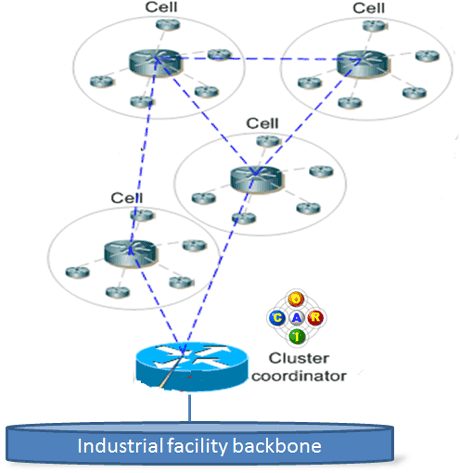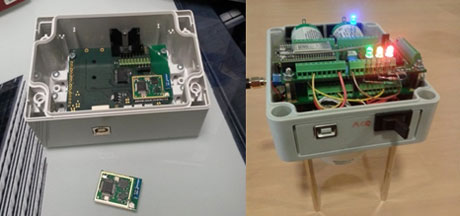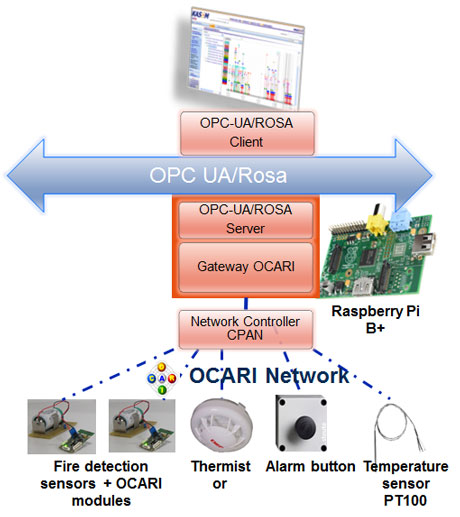by Tuan Dang, Pascale Minet and Erwan Livolant
OCARI is a wireless sensor network designed to operate in industrial environments [1]. It is easy to deploy (i.e. ‘plug-and-play’), and is energy-efficient to support battery-operated nodes. OCARI nodes use commercial off-the shelf components. OCARI provides bounded medium access delays and the energy consumption of an OCARI network is predictable. In addition, the network is scalable (up to hundreds of sensor nodes) and able to support micro-mobility of nodes.
OCARI can be distinguished from WirelessHart and ZigBee by the following three characteristics:
- It relies on a mesh topology (see Figure 1), improving robustness and bandwidth use.
- It is self-configuring thanks to a dynamic multihop routing taking energy into account.
- It saves energy thanks to a deterministic medium access and sleeping periods for nodes.
Furthermore, OCARI has the advantage of being open source.

Figure 1: OCARI topology.
The OCARI stack comprises the Physical, MAC, Network and Application layers. It was first developed in the ANR OCARI project lead by EDF with Inria, LIMOS, LATTIS, LRI, Telit and DCNS. Today, it is actively developed by EDF, Inria, in collaboration with ADWAVE and other research labs. The network layer includes OPERA (OPtimized Energy efficient Routing and node Activity scheduling) that consists of:
- EOLSR, an energy-efficient routing including neighbourhood discovery and building of the routing tree rooted at the sink in charge of data gathering.
- OSERENA, [2] a colouring node protocol allowing a conflict-free schedule of node medium accesses to be built. Each node knows the time slots in which it is allowed to transmit or it may receive from a neighbour. In the remaining slots it sleeps to save energy.
OCARI takes advantage of cross-layering [3] to optimize its performance. From the hardware point of view, an OCARI node consists of a radio frequency transceiver compliant with the IEEEE 802.15.4 standard operating in the 2.4GHz band and a 32 bits Cortex M3 microcontroller. OCARI is presently available on two platforms: Dresden deRFsam3-23T09-3 and ADWAVE ADWRF24-LRS (see Figure 2).

Figure 2: OCARI on Dresden platform (left) and on ADWAVE platform (right).
OCARI has been demonstrated many times, the most recent two demonstrations in November 2014:
- Demonstration during the Inria-Industry Telecom day: routing and colouring, fire detection on a DCNS ship construction site using ADWAVE hardware (see http://www.inria.fr/en/innovation/ calendar/telecoms-du-futur).
- Demonstration for the steering committee of the Connexion Cluster project (https://www.cluster-connexion.fr): integration of sensors of various types in the OCARI network and interconnection of the OCARI network to the facility backbone by means of a OCARI/OPC-UA gateway built with Telecom ParisTech on a Raspberry Pi (see Figure 3).

Figure 3: Gateway OCARI/OPC-UA.
In the future, we plan to create an alliance, bringing together industrial end users (e.g., EDF, DCNS), sensor providers (e.g., DEF, Carmelec), research labs (e.g., Inria, Telecom ParisTech), integrators of network solutions (e.g., ADWAVE), SMEs and engineering service companies using wireless sensor networks (e.g., ATOS, PREDICT). The objectives of the OCARI Alliance are to create a sustainable ecosystem, gather feedback on real OCARI deployments and fund functional evolutions of OCARI.
Link: http://www.ocari.org
References:
[1] T. Dang et al.: “Which wireless technology for industrial wireless sensor network? The development of OCARI technology”, IEEE Transactions on Industrial Electronics, 2009.
[2] I. Amdouni, P. Minet, C. Adjih “OSERENA: a coloring algorithm optimized for dense wireless networks", the International Journal of Networked and Distributed Computing (IJNDC), vol. 1, issue 1, November 2012.
[3] K. Al Agha, et al.: “Cross-layering in an industrial wireless sensor network: case study of OCARI”, JNW, Journal of NetWorks, special issue on Wireless sensor network: theory and practice, Academy Publisher, 2009.
Please contact:
Tuan Dang
EDF, STEP department, France
E-mail:
Pascale Minet, Erwan Livolant
Inria, France
E-mail:











